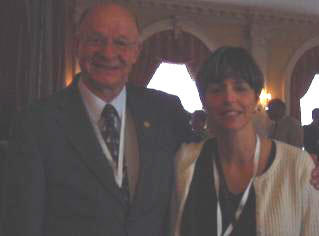Dr. Diane Stemple: Cheese Possession Continues at the 2005 American Cheese Society Conference

The American Cheese Society’s yearly conference includes the most prestigious collection of cheesemakers, retailers, distributors, and cheeselovers, if you are in the farmstead camp as opposed to big commercial cheese. The yearly cheese competition which is a big part of the conference brings in over 700 cheeses in about ninety categories and is judged by ten pairs of judges: one aesthetic and one technical in each pair. This year I had the amazing honor after only four years in the cheese world of being an aesthetic judge. I was extremely excited and hoping I would measure up to the challenge ahead.
In the morning I arrived at the Louisville Marriot Hotel where the competition was being held, and met my fellow judges, some of whom were judging at the ACS competition for the first time, which made me feel a lot better. But the technical judges: they were an extraordinary crew of people. Most of them were extremely experienced men from the Wisconsin cheese world, and had judged contests for years. I was paired with Bill Schlinsog who turned out to be a generous and kind expert who shared his perspective and vocabulary and wry sense of humor freely once we got used to each other and I calmed down. Each pair of judges evaluate many categories of cheese, and some are more interesting than others. They try to disperse the categories fairly among the judges. No one really wants flavored cheeses first thing in the day because your palate will get overwhelmed, so the organizers wisely divide and time the more palate challenging cheeses, but we all get some. We had flavored goat, and we ended up really liking our top choices, and so did others later. But it is hard to get chives or pepper in your mouth when you know you have hours more of cheese tasting to go. One needs to pace oneself. My partner Bill spits most of the cheese out, but not until it has been in his mouth for a while, and he tried to convince me to do so but it just didn’t take. Only if I really didn’t care for a cheese: then I would spit it into a napkin, but I just couldn’t spit out a mouthful of syrupy cheese. Yuck. I didn’t get as full as I thought I would. You take very small tastes, but I always took at least two, because I teach my own cheese classes that you have to taste something twice to get the whole picture, and so I couldn’t not take my own advice in such a serious situation. These cheesemakers are counting on me! A small cheesemaker can really benefit from getting a first place in their category, or how bout “Best in Show”? It was a very serious endeavor for all of us in the room.
So Day One we did eight Mature Cheddars (36-48 months), nine flavored goat cheeses, one flavored cheese from sheep, and 17 Fetas from all three types of milk (that was rough). Several cheeses were quite spectacular and I couldn’t wait to serve them in my home.
Day Two, the final day of judging, was much more exciting. I didn’t have to be nervous anymore since my fellow judges and the people running the competition had made me feel welcome and competent. We were scheduled to judge some exciting categories that day like Aged Farmstead (cheeses made with milk from the animals on that farm) and Washed Rind goat and sheep milk cheeses. So what we were tasting was much more interesting, and closer to Murray’s type of cheese so I felt my expertise was well matched to the cheeses. By Thursday Bill and I were getting along great and I was noticing that he did not always spit, plus I got him to taste some rind. We had developed into a well oiled team. The amazing part was with our totally different backgrounds (his from industry, mine from mostly eating and selling), we always agreed on the cheese. You don’t exactly look at each other’s scores- and I think I was probably a tougher scorer. From the start I did not let my novice status affect my opinions, and then once I started scoring in a certain way, I felt I had to be consistent with myself. But I think we always agreed on the winners and the losers. The middle was probably a little murky. After the categories are all finished, the top winners in each category are brought back into the room so that all the teams can evaluate all the first place winners to eventually determine “Best in Show.” By now there is such an array of excellent cheeses: from ricotta, to butter, to flavored, to spreads, through cheddars and colbys, and farmstead and blues. As a retailer I of course recognized some favorite cheeses. At one decision point I asked Bill to select because I didn’t trust myself to be impartial. (I may have influenced him with body language, but I kept my mouth shut.) He was very thoughtful, took his time and when he picked my favorite, I felt so happy and vindicated, I was shocked at how emotional I was.
In the end, Pleasant Ridge Reserve from Uplands Cheese in Wisconsin won “Best in Show.” It is truly an amazing American Farmstead cheese, one I always serve in my Old World vs. New World cheese class because it can reliably beat the tough European competition. The cheesemaker, Mike Gingrich, is a well loved member of the cheese community and two days later at the Awards ceremony the applause and standing ovation for him and his wife was long and genuine.
------------------------------------------------------------
Dr. Diane Stemple was featured in the New York Times article, "By Cheese Possessed".
She is also teaching an "American Cheese Society Winners 2005" Cheese Course class on Thursday, August 11, 2005, 6:30-8:00pm



<< Home